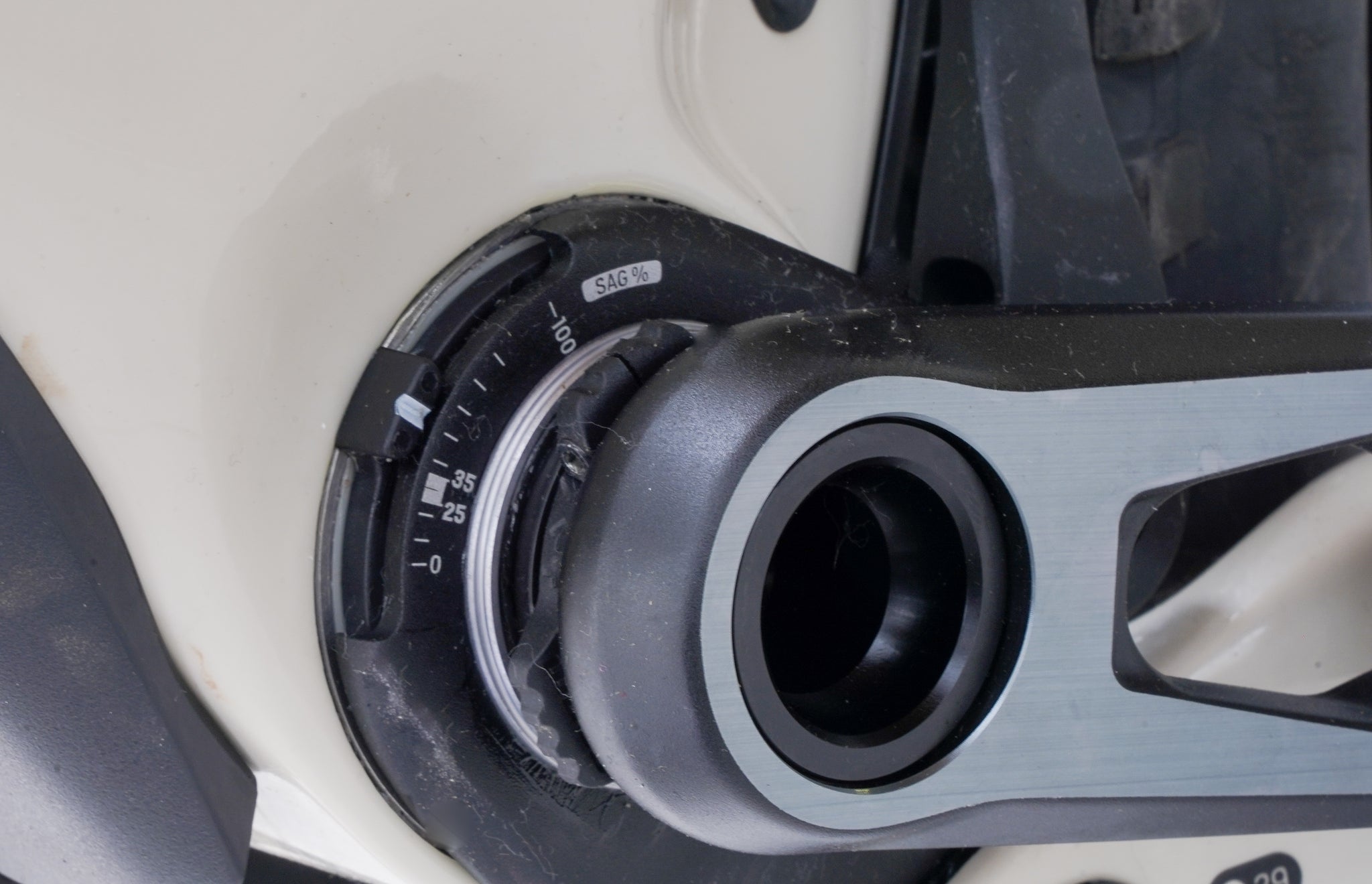
The All-New SCOTT Ransom
As a staple in the SCOTT lineup, the Ransom quickly became SCOTT's enduro go-to bike in 2018. After six years of World Cup podiums and riders like Brendan Fairclough pushing the Ransom to its absolute limit, SCOTT recognized it may be time for a change. The bike received a frame up redesign with a number of part changes to go with the new technology. The new Ransom was engineered to provide uncompromising downhill performance while maintaining confidence in pedaling back up the hill. With that in mind, SCOTT overhauled the bike's geometry and suspension kinematics.
GEO FOR DAYS
The 2024 SCOTT Ransom has had some decent changes to the geometry, getting that “longer, lower” treatment we have all come to expect with new bike designs. The Ransom has gone to the even slacker side of things. In size Medium (low flip chip position), the new 2024 Ransom has gotten 18.5mm longer in the reach, 0.7° slacker head angle, and a 22.9mm longer wheelbase. The biggest change of all, the seat tube angle went from 75° to 77.2°, a whole 2.2° difference. But what does this mean? When you slack out a bike further on an already fairly slack bike, it will be more stable at high speeds, due to an increase in wheelbase length (for you skiers out there, its similar to going to a longer ski/wider underfoot). The slackened head angle also helps the front wheel with its approach angle when it hits an obstacle. There is now less force required to get the fork to compress and the wheel can roll up and over the obstacle easier as well. When you make a head angle slacker, the rider sits back from the front wheel and the front wheel has less weight on it, especially climbing. This can make the front wheel wander and make climbing a chore, which is why the big change is the steeper seat tube angle. By making that steeper by such a severe degree, the riders sits more over the front wheel. While this would cramp the cockpit feel a bit, the reach on this bike grew 18.5mm longer, which is a pretty big difference. As an example on the 2021 Ransom, going from a Medium to a Large is a 27mm long jump in reach. So, this change in reach in the new Ransom is essentially going up a size in the bike. All of these overall changes also led to a 3.5mm lower BB height. In an effort to make it not feel too big, they made the top tube slope significantly more than the previous generation, bringing the standover down almost 21mm lower. All of these changes bring this bike in spec with more modern enduro bikes and are in line with what we would want to see on a current enduro race bike.

One of the more interesting things on the Ransom was it's increased stack height and increased trail numbers. This goes along with some of the industry predictions several journalists have been talking about recently. If you are well into the tech scene and love learning about bikes, you might have seen the video by Henry Quinney, talking about how the next big number in his mind was stack height. And his prediction is true, the stack height on the 2024 Ransom increased almost 6mm in the same size compared to the previous model, along with the trail growing by 13mm as well. Henry dives deeper into this concept in his video but basically the issue lies in the “longer, lower” theory. As they push to get enduro bikes as stable and as capable as possible, they keep pushing these bikes longer and longer, but those numbers are coming to an end. Bikes can only get so long and so slack before they suffer from some extreme wheel flop, making bigger bikes feel like a burden at lower speeds.
What is wheel flop? If you have ever ridden a bigger bike and while climbing or at slow speeds you put a little bit of force onto let's say the right side of the handle bar and the entire bike seems to dive right. Almost like an extreme form of over steering, but instead of just a little bit the right way, this phenomena is called "wheel flop" and seems to plague bikes of bigger travel and slacker head angles. This is due to the way bikes stabilize and stay upright. Most people think it is due to the gyroscopic forces of the wheels keeping it up, but it's not. It's more similar to the Caster effect - like wheels on shopping carts where due to the steering axis of the bike, the wheels follow where you steer and self stabilize. Because the contact patch of the wheel is farther in front of you, compared to where you are steering, the wheel is trying to follow you. This is more notable when you realize you cannot really turn right or left, without slightly counter steering in the opposite way first. If you're more curious on how this works, check out a great video on YouTube called "Most People Don't Know How Bikes Work" by Veritasium. They go over the findings on this subject by Cornell University, among others. The increase in stack height on bikes is to help combat this wheel flop and make bikes feel more manageable. And the Ransom reflects this thought process. Bike companies as a whole have started to realize this, after spending the last four years making bikes as slack as possible. They now realize they need something to help combat that flop.
But how does increasing stack (and subsequently, the trail) actually help this? A big portion of making bikes slacker, is to make them more stable on steep terrain, but you can do the same thing with stack. Increasing stack height lets the front end be raised up, which changes our body position to let us have more weight on the balls of our feet, and lowering our center of gravity on the bike, so we don't need to slack the head angle out as much for the same stability. This helps to prevent excessive wheel flop. This is also why SCOTT only went to a 63.8° head tube angle and no slacker. Well you might be asking, "why not just raise your stem up, doesn't that do the same thing?" Sure, while your on-the-bike position might be the same, changes to the cockpit, stem, and bar raise up your position in front of the steering axis. Doing this messes with that Caster effect, making the front end feel vague and unsure. Raising a bike's stack raises it AT the steering axis, instead of IN FRONT of the steering axis. All pointing to SCOTT's No Shortcut's thinking when designing this bike.

TECH GALORE
New model means new tech and the Ransom is no exception. Since SCOTT bikes acquired Bold in 2019, their bikes have been using an internal rear shock to protect it from the elements and the new Ransom is no different. The new internal rear shock can run coil, piggyback and larger air can size shocks, which the previous model bike was not able to do. The new bike uses a six-bar linkage shock layout, giving the bike a more progressive leverage ratio. The suspension was also heavily tuned in its kinematics for a more predictable anti-rise, and trying to keep pedal kickback low. All welcome changes! The shock still has SCOTT's “NUDE” technology with a remote lockout for the rear, with an open and climb (“traction”) mode, but interestingly the new Ransom loses its front lockout (which is in our opinion is a welcome change).

The bike is also much more adjustable than the previous generation with a mullet (29" Front and 27.5" Rear) and a 29" capability, along with headset adjustment cups and flip chips. It also has a much straighter seat tube letting you run much longer dropper posts per size! Setting the sag is as easy as can be with it written on the side of the frame, so you can sit down on the bike, look down and see what the external indicator says. With an internal shock, sticking a ruler in your frame to measure your sag would certainly be difficult, so having an external way to read sag helps reduce any negatives of the internal rear shock. The Ransom also now features a huge amount of in-frame storage for tools, tubes and inflation.

BUZZING ABOUT DETAILS, SMALL GRIPES + GREAT PLUSES
Let's get it out of the way, PF BB. Yes, that's right, it uses a press fit bottom bracket. We would have preferred to see a threaded bottom bracket on a bike that is likely going to see a lot of rough and tumble. Our other concern is that the chainstays are 440mm across all sizes. While it probably feels great, it is now somewhat common to see chainstay length grow and shrink according to size. Next, while questioning the use of a fully-integrated cockpit on a bike with this much travel, we still have to admit that it looks awesome. On the positive side, SCOTT made some other small changes that we love. The bike is now UDH allowing it to be able to run SRAM’s Transmission groupsets. The bikes come standard with some huge sized rotors, 200mm front and rear, with no need for an adapter in the rear, which is a huge plus. We are also fans of the fact that they spec'd proper tires, with actual durable casings instead of the weight-saving, too thin tires for a bike this big.

Overall, the new SCOTT Ransom is a super-sweet enduro bike with the attitude to match its looks. We are very eager to get this bike on a trail. If you have any questions, chat with us here on the site, call us or shoot us an email.